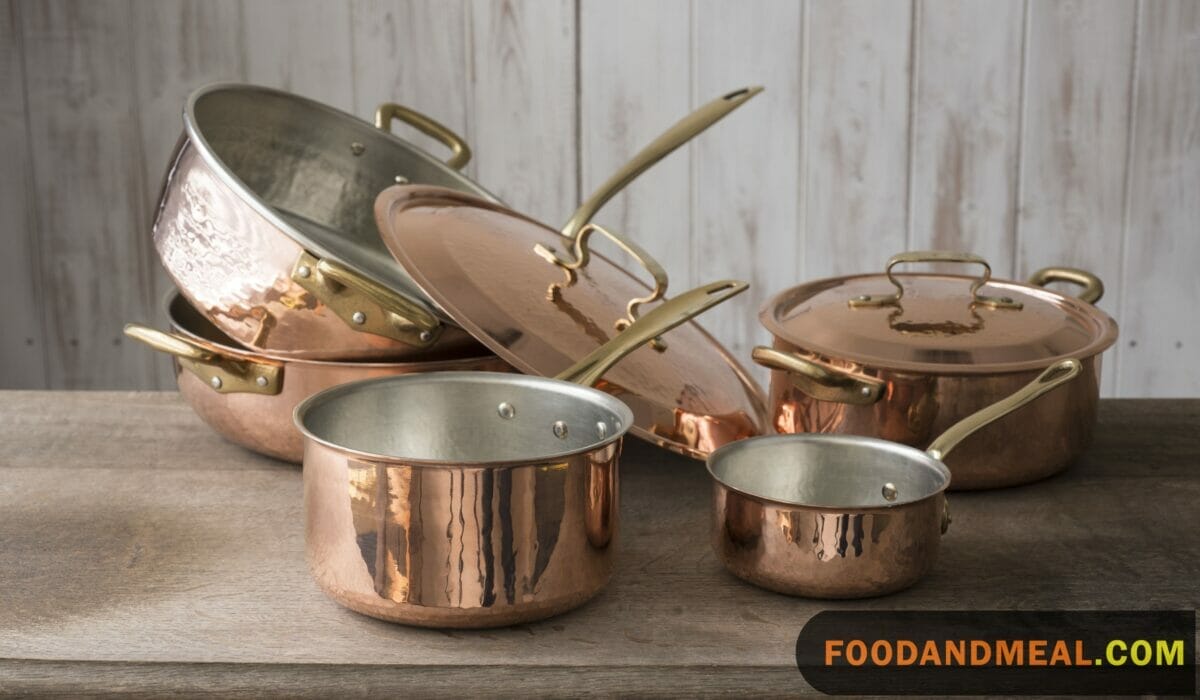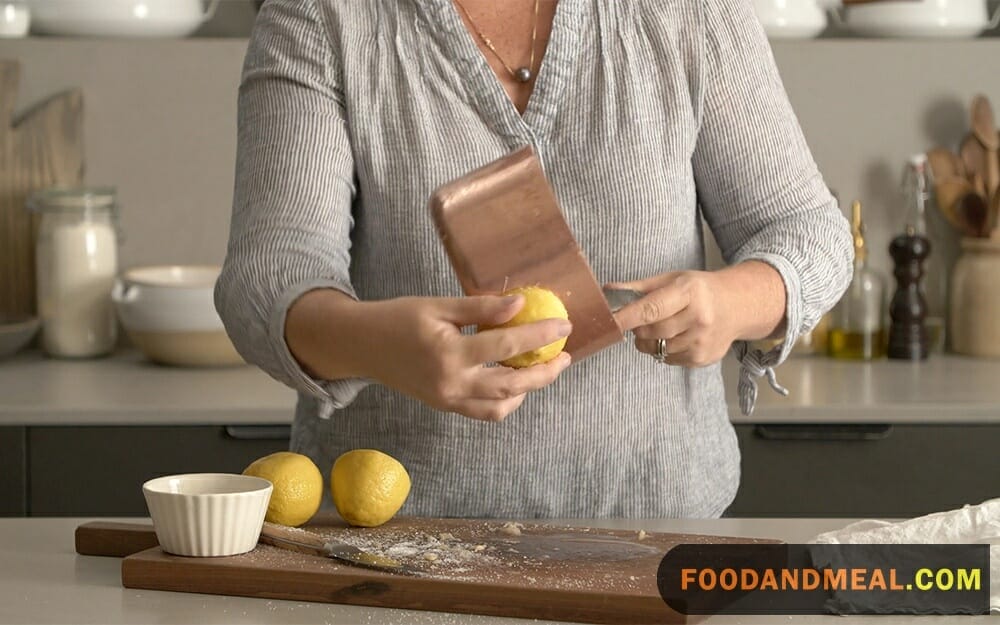Is the luster of your copper pots, pans, and mugs fading away? If your copper kitchenware appears lackluster and tarnished, it’s likely a signal that it’s due for some polishing to revive its initial splendor. Discover the complete guide on cleaning and polishing your copper items to ensure they maintain their exquisite appearance for years to come.
How to Wash Copper Cookware
The optimal approach for cleaning copper pots and pans involves using warm water and mild dish soap. Employ a soft, non-abrasive cloth, brush, or sponge to gently eliminate any residues. If dealing with stubborn food remnants, immerse the pan in hot, soapy water for 15 minutes before scrubbing once more.
It’s crucial to steer clear of rough, abrasive cleaning tools or harsh cleaners such as Bon Ami when caring for your copper cookware. After washing, always hand-dry your copper pots and pans promptly. Allowing them to air dry might result in unsightly water spots and accelerate the tarnishing process of the metal.
Can You Put Copper in the Dishwasher?
Copper cookware demands manual washing and should never be subjected to a dishwasher cycle.
However, there are exceptions to this guideline when it comes to copper-colored utensils and various kitchen tools. These items are typically constructed from stainless steel, featuring a copper-colored plating, but they do not actually contain copper. It’s advisable to verify the manufacturer’s instructions, but generally, such items can be safely placed in the dishwasher.

How Do You Tell If Copper Is Lacquered?
Certain copper cookware items are highly valued for their unique interactions with the substances they contain. For instance, copper mixing bowls play a pivotal role in stabilizing whipped egg whites, while the smooth surface and exceptional heat conductivity of copper pans make them an ideal choice for crafting jams.
Nevertheless, it’s worth noting that some copper cookware is coated with a glossy, reflective lacquer finish, as opposed to the more subtle radiance of unlacquered copper. This lacquer serves the dual purpose of maintaining the copper’s sheen and preventing tarnishing. If your cookware fails to develop a slight patina over time, there’s a strong likelihood that it is lacquered. For absolute certainty, you can refer to the packaging or contact the manufacturer for clarification.
How to Clean Lacquered Copper
For a more detailed approach to cleaning lacquered copper cookware, adhere to these steps: Begin by delicately washing the item with warm, soapy water. Ensure thorough coverage of the surface, gently scrubbing if necessary. Next, rinse the cookware meticulously to remove any soap residue. Finally, take extra care to dry it by hand using a soft, clean cloth, ensuring it’s completely dry to maintain its lustrous appearance.
How to Clean Lined Copper
Certain copper cookware is furnished with either tin or stainless steel linings on the interior, ensuring a non-reactive cooking surface. To maintain their quality, it’s essential to hand wash and meticulously dry these items. While you can polish the copper exterior, it’s crucial to avoid polishing the tin or stainless steel lining.
It’s important to note that copper cookware lined with tin may naturally darken and develop a patina with regular use over time. Additionally, after years of use, these items may require re-tinning. If you start to notice bits of copper peeking through the tin lining, this is a clear indicator that it’s time for re-tinning.
How to Remove Tarnish From Copper Pots Without Chemicals
Over time, even well-maintained unlacquered copper pieces will naturally develop a mild tarnish due to their exposure to elements like oxygen, moisture, dust, sunlight, heat, and the natural oils from our hands. If left unattended, this tarnish can lead to corrosion, presenting itself as brown or black spots and uneven dark areas rather than the original uniform shine.
For objects not intended for contact with food, leaving this patina in place as an aesthetic choice is an option. However, if you plan to use the item in your kitchen, it’s advisable to remove the tarnish through polishing. It’s worth noting that due to copper’s reactivity, it’s best to avoid cooking acidic foods such as tomatoes and lemons in unlined copper cookware, as this can potentially result in copper leaching into your food and causing health concerns.
To restore the luster of your copper items, you can opt for a product like Wright’s Copper Cream and polish them every six months or as needed. Alternatively, there are several effective DIY methods for cleaning copper cookware that don’t require the use of harsh chemical cleaners. The fundamental approach to cleaning copper involves utilizing acid and salt.
How to Clean Copper With Ketchup or Tomato Paste
One effective method for dealing with mild tarnish on copper surfaces is to create a natural cleaning mixture using common kitchen ingredients. This approach involves combining two parts tomato paste or ketchup with one part coarse salt to form a cleaning paste.
Here’s how to go about it:
- Prepare the Mixture: Start by mixing two parts of either tomato paste or ketchup with one part coarse salt. The salt acts as an abrasive agent while the tomato paste or ketchup provides mild acidity, which helps break down the tarnish.
- Application: Apply the resulting paste generously onto the tarnished areas of the copper surface. Make sure to cover the affected areas evenly.
- Waiting Period: Allow the paste to sit on the copper for a couple of minutes. During this time, the natural acids in the tomato paste or ketchup, combined with the abrasive action of the salt, will work to loosen and remove the tarnish.
- Rinse and Dry: After the waiting period, rinse the copper item thoroughly with warm water. Ensure all traces of the cleaning mixture are washed away. Finally, dry the copper pan or object carefully by hand using a soft, clean cloth.
This gentle and natural method effectively removes mild tarnish from copper surfaces, leaving them looking cleaner and more lustrous. It’s a safe and eco-friendly way to maintain the beauty of your copper cookware.
How to Clean Copper With Lemon and Salt

When faced with persistent tarnish on copper surfaces, a more potent approach involves using a combination of lemon and kosher salt. Follow these steps to restore the shine to your copper items:
- Prepare the Lemon and Salt Mixture: Begin by cutting a lemon in half and dipping the cut side into kosher salt. The salt provides an abrasive element while the lemon’s natural acidity helps break down the stubborn tarnish.
- Scrub the Surface: Use the lemon and salt mixture to scrub the affected areas on the copper surface. Apply gentle pressure and work the mixture into the tarnished spots. Within a few minutes, you should start to notice the shine returning to the copper.
- Rinse and Clean: Once you’ve achieved the desired level of brightness, wash the item thoroughly with dish soap and warm water. Make sure to remove any remnants of the lemon and salt mixture.
- Thoroughly Dry: To prevent any future tarnishing, hand dry the copper item meticulously with a soft, clean cloth.
This method effectively tackles stubborn tarnish on copper surfaces and leaves them looking renewed and radiant. It’s a natural and practical way to maintain the beauty of your copper cookware and other copper items.
How to Clean Copper With Vinegar

For heavily tarnished copper items that require more than just acid and salt, applying heat can be an effective solution. This technique is suitable for items that can fit inside a larger pot on the stove. Follow these steps to restore such tarnished items:
- Prepare the Solution: In a large, non-reactive pot, combine one cup of white vinegar, three cups of water, and one tablespoon of salt. This mixture will help break down the tarnish.
- Submerge and Heat: Place the heavily tarnished copper item into the pot, ensuring it is fully submerged in the liquid. Then, set the pot on the stove over high heat and bring the solution to a boil.
- Watch for Progress: As the solution heats up, you may notice bits of tarnish detaching from the copper item and entering the liquid. This is a sign that the tarnish is loosening.
- Turn Off Heat and Cool Down: Once you observe significant improvement, turn off the heat and allow the pot to cool down. The cooling process helps solidify the tarnish and make it easier to remove.
- Remove and Clean: Retrieve the copper item from the pot and use one of the previously mentioned methods (like the lemon and salt mixture) to clean off any remaining tarnish.
This method leverages the combination of heat, acid, and salt to effectively remove stubborn tarnish from copper surfaces. It’s particularly useful for restoring heavily tarnished items to their original luster, ensuring they maintain their timeless beauty.
FAQs
- Q: Why is it important to clean copper cookware regularly?
A: Regular cleaning helps maintain the appearance and performance of copper cookware. It removes tarnish, prevents oxidation, and ensures the longevity of your kitchen equipment.
- Q: Can I clean copper cookware in the dishwasher?
A: It’s not recommended to clean copper cookware in the dishwasher. Hand washing is preferable to prevent harsh detergents and high water pressure, which can damage the copper and affect its appearance.
- Q: What should I use to clean copper pots and pans?
A: Mild dish soap, warm water, and a soft sponge or cloth are suitable for cleaning copper cookware. For tougher stains or tarnish, a mixture of salt and vinegar or a commercial copper cleaner can be effective.
- Q: How do I remove tarnish from copper cookware?
A: Create a paste using equal parts of salt, flour, and white vinegar. Apply the paste to the tarnished areas, let it sit for about 15-20 minutes, and then gently scrub with a soft sponge or cloth. Rinse thoroughly.
- Q: Can I use abrasive pads or steel wool to clean copper pots?
A: Avoid using abrasive pads or steel wool, as they can scratch and damage the copper surface. Stick to softer materials like sponges or cloths to preserve the cookware’s appearance.
- Q: How do I clean the interior of copper cookware?
A: For the interior, mix a solution of equal parts salt and vinegar. Apply the mixture with a soft cloth or sponge, gently scrubbing any stains. Rinse thoroughly with warm water.
- Q: Is it safe to use lemon or vinegar for cleaning copper cookware?
A: Yes, lemon and vinegar are mildly acidic and can be effective for removing stains and tarnish from copper. However, ensure you rinse the cookware thoroughly after cleaning to avoid any lingering acidity.
- Q: Can I use ketchup to clean copper cookware?
A: Yes, the acidity in ketchup can help remove tarnish from copper. Apply a thin layer, let it sit for about 15 minutes, then scrub gently with a soft cloth or sponge. Rinse thoroughly.
- Q: How do I polish copper cookware to maintain its shine?
A: Use a commercial copper polish or make a paste with equal parts of lemon juice and baking soda. Apply the polish with a soft cloth, buff the copper, and then rinse and dry thoroughly.
- Q: Can I store food in copper cookware?
A: Copper cookware is not recommended for storing food, as it can react with certain ingredients. Use copper cookware for cooking and serving purposes, and transfer food to appropriate storage containers for later use.
I'm Kelly Atkinson, with a passion for dissecting the world of home goods. My reviews stem from thorough testing and a love for sharing detailed insights. Each piece I write offers a glimpse into my explorative journey, aiming to guide readers to informed choices with authenticity and precision, making every review a blend of exploration and expertise.
